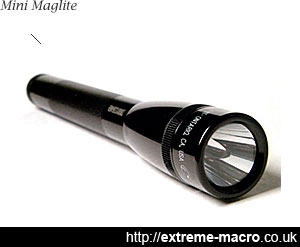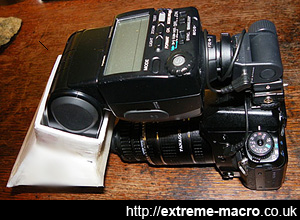Field Lighting
by Johan J Ingles-Le Nobel
Last updated August 31, 2017
When you're out in the field, you need your kit to be as small and manoeuvrable as possible, and they are the primary considerations in my field lighting setups.
The big difference thought between studio and field lighting is that with studio lighting artificial lighting sources are your only form of light, but with field lighting there is a choice of whether to add in the ambient lighting produced by the sun. So in field lighting we often balance the two forms of light.
Lighting for Day Macro
Diffused flash used for extreme macro on a horizontal setup. Rather than having the flash sit on an arm fixed to the camera, I opted to lean the flash over the subject like this using some adjustable shoe mounts and PC-sync with manual flash mode.
The horizontal setup works well because the flash is very near the subject so you need to use far less battery power, which means longer lasting batteries and faster recharge times.
There are really two types of daytime macro that need to be catered for: closeup extreme macro with a working distance up to 25cm or so, and standard butterfly macro that focuses on subjects farther away.
People most commonly use a flash bracket with a flash rigged on this angled towards the subjects for their extreme macro, but having tried and tested various brackets I ended up using a different horizontal setup.
The horizontal setup works well because the flash is very near the subject so you need to use far less battery power. I have also experimented with various beauty dish variants and these can work well too.
LED Panels for Macro
I have seen very good things written about LED light panels, but the one I tried didn't have enough LEDs on it to make the exercise worthwhile. Look for a panel with as many LEDs as possible otherwise it is not worth doing. Reflecting panels supported by a plamp also have a large role to play in field macro.
Balancing flash and ambient for daytime macro of things like butterflies on a stalk against a nice smooth background is mostly a matter of understanding the balancing technique and finding the right angle. A cheap snoot from eBay helps you isolate your subject.

Mini maglite unit that I use on a mount when doing nighttime macro. These little maglites are great because you can focus the light on them by twisting the end, very handy.£10 online.
Lighting for Night Macro
For night macro you want to be able to add a torch to your setup to be able to see what you're doing. The setup I've created using GoPro bits and pieces does this extremely well, and doing macro at night opens up a very different world to the camera.
Night macro is a great way to extend your macro shooting hours if like me you have a day job. Also, rather than the flies and wasps, the night macro world is much more one in which the walking insects come out, as their predators have gone to sleep.
UV Lighting for Fluorescence Macro
Fluorescence is activated ('excited') by using long wave UV, and shooting extreme macro fluorescence is something that I've recently added to my repertoire. The best light source for this is the fourth one I tried and I can now use this, some unusual settings in the camera and a blocking filter to show things that weren't possible 5 years ago because of the lack of light sources on the market.
Black light has become much more affordable for the consumer with the increase in LED technology, and there are now relatively simple ways to give yourself a blacklight UV camera which will give you extreme macro UV photography.
Related Articles






